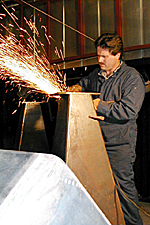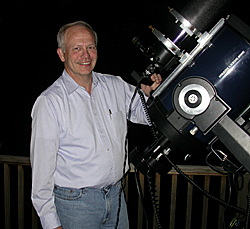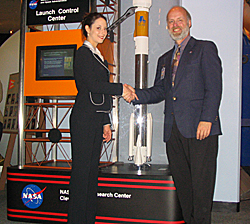Student Features
Small Scopes, Big Impact
06.29.05
| Who Are NASA's Space Science Explorers? Who are NASA's Space Science Explorers? The scientist studying black holes in distant galaxies. And the engineer working on robotic machines bound for space. But also the teacher explaining the mysteries of the cosmos. And the student wondering if there is life beyond Earth. All of these people are Space Science Explorers. They are all linked by their quest to explore our solar system and universe. This monthly series will introduce you to NASA Space Science Explorers, young and old, with many backgrounds and interests. Nominate a Space Science Explorer! Tell us about the Space Science Explorers you know. We're looking for students, teachers, scientists and others who have a connection to NASA, whether they work for the agency or are involved in a NASA-supported mission or program. Send your nominations to Dan Stillman: dan_stillman@strategies.org. |
This Fourth of July will be one to remember for scientists at NASA. For six years they've been working toward this day. If all goes as planned, their 820-pound space probe will smash into a comet about half the size of Manhattan. The crash is expected to expose the insides of comet Tempel 1. Scientists hope to find materials frozen in time since the solar system first formed.
But workers at NASA aren't the only ones looking forward to the fireworks in space. There's also another group of excited people -- astronomers all over the world. Many have had a key part in the comet-crashing mission called Deep Impact.
 |
Setting a manmade probe on a collision course with a comet is tricky business. The probe will be traveling at more than 50,000 mph. And the comet is streaking through space at almost 67,000 mph. The exact path of the comet must be known so the probe can be steered to the right place at the right time.
Image to right: Tim Puckett estimates he spent about 10,000 hours over eight years building a telescope from parts he found at scrap yards. Credit: NASA
NASA uses jumbo telescopes on the ground and in space to watch the comet. They have diameters as large as 400 inches. Problem is, there aren't that many of them. And often they're being used for other projects. So in order to keep a constant eye on Tempel 1, NASA needed some help. It set up the Small Telescope Science Program. Astronomers across the globe were asked to focus their telescopes on the comet and send their images to NASA.
One person who jumped at the chance to help out was Tim Puckett. His eagerness, though, is not a surprise once you know his story. Puckett has always been fascinated by the stars. Unable to afford the kind of telescope he wanted, Puckett decided to make his own. He did this with parts he found at scrap yards. It took about 10,000 hours over eight years. But when he was done, Puckett had himself a homemade 24-inch telescope. Now, he has his own telescope company. And he operates an observatory in Georgia.
 |
"For me it was the wonder and mystery of the sky," Puckett said. "To be out under the stars makes one feel alive, and also very small at the same time."
Image to left: Ralph Pass prepares his telescope for a viewing of the night sky. Credit: NASA
Ralph Pass also has his own observatory -- on the deck of his Massachusetts home. He first tried to view Tempel 1 back in 2000 and 2001. Those attempts were often ruined by clouds. But Pass did succeed in helping out with another NASA mission. A few years ago, NASA was having trouble getting a good view of a comet named Borrelly. This was just before a spacecraft was to fly near the comet and take pictures of it. So NASA called on Pass for help. He was able to capture images of the comet using his 10-inch telescope.
This "gave me a deep sense of pride," Pass said. Lately, he's had good luck seeing Tempel 1 as well.
Then there's Jay Reynolds. Growing up in the 1960s, he was excited by the space race and trips to the Moon. "You couldn't open a box of cereal without having some sort of space toy in there," Reynolds remembers. "Space was really a part of the fabric of this country." Reynolds now runs a planetarium and teaches astronomy at two colleges. And he talks to the media about space science.

|
Image to right: Danitra Donatelli and Jay Reynolds shake hands after giving a talk at NASA's Glenn Research Center in Cleveland, OH. Credit: NASA
Reynolds was thrilled when he heard NASA was looking for help with Deep Impact. He saw a perfect way to involve his students in real science. He quickly formed a comet-watching group that soon began sending images to NASA. Students like Danitra Donatelli were happy to take part. "For me to be able to participate in something like this was absolutely elating," she said.
The watchful eyes of astronomers have become even more important as of late. That's what Lucy McFadden says. She's one of the scientists working on Deep Impact. She says the closer impact day has gotten, the more the science team has had to focus on making sure the probe is ready. That means looking at computer screens more so than looking to space. Luckily, astronomers around the world are watching Tempel 1. "Someone has to look up," McFadden said.
See previous Space Science Explorers articles:
+ View site
Related Resources
What Powers a Comet?
+ View site
Tails of Wonder
+ View site